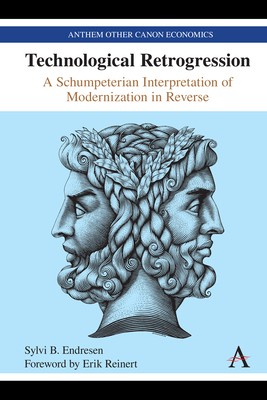
- We will send in 10–14 business days.
- Author: Sylvi B Endresen
- Publisher: Anthem Press
- ISBN-10: 1785277138
- ISBN-13: 9781785277139
- Format: 15.2 x 22.9 x 1.8 cm, hardcover
- Language: English
- SAVE -10% with code: EXTRA
Reviews
Description
The aim of this book is to broaden our understanding of technological change by adopting the concept of technological retrogression. With reference to concrete cases of technological retrogression a new conceptual framework is developed. The book's exposition aims at contrasting retrogressive economic dynamics of technological change to progressive dynamics as developed by Schumpeter. At one extreme in the dimension of technological change, capital-strong production units innovate their way out of the recession through technological progress, adopting more advanced production equipment that improves productivity. Following Schumpeterian progressive dynamics, virtuous spirals of growth result. At the other end we find the producers that resort to technological retrogression, which secures survival, but which result in low labour productivity, diminishing the possibility of capital accumulation and thus modernization that could form an escape from poverty. Vicious spirals of decline result, which is the book's main object of analysis. The theory is, thus, a contribution to understanding the anatomy of recessions.
EXTRA 10 % discount with code: EXTRA
The promotion ends in 17d.10:03:47
The discount code is valid when purchasing from 10 €. Discounts do not stack.
- Author: Sylvi B Endresen
- Publisher: Anthem Press
- ISBN-10: 1785277138
- ISBN-13: 9781785277139
- Format: 15.2 x 22.9 x 1.8 cm, hardcover
- Language: English English
The aim of this book is to broaden our understanding of technological change by adopting the concept of technological retrogression. With reference to concrete cases of technological retrogression a new conceptual framework is developed. The book's exposition aims at contrasting retrogressive economic dynamics of technological change to progressive dynamics as developed by Schumpeter. At one extreme in the dimension of technological change, capital-strong production units innovate their way out of the recession through technological progress, adopting more advanced production equipment that improves productivity. Following Schumpeterian progressive dynamics, virtuous spirals of growth result. At the other end we find the producers that resort to technological retrogression, which secures survival, but which result in low labour productivity, diminishing the possibility of capital accumulation and thus modernization that could form an escape from poverty. Vicious spirals of decline result, which is the book's main object of analysis. The theory is, thus, a contribution to understanding the anatomy of recessions.


Reviews